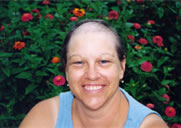 |
The facts about pulling
People pull from varying sites on the body, including the scalp, eyelashes, eyebrows, pubic region, face and extremities.
Some people pull from specific spots resulting in bald areas, while others pull in a sparse pattern, thus creating a thin appearance. Still others who engage in daily pulling may exhibit complete baldness on the scalp or other parts of their bodies, or even a total loss of eyelashes or eyebrows.
More than half of people with trich report pulling hairs that are "coarse," "thick," or "kinky. Because repeated pulling can cause normal hair to grow out more coarse or curly, people can create a cycle that leads to greater pulling of those particular hairs (Christenson, 1995a).
Touching the hair usually comes before pulling (Mansueto, 1990) and pulling is often done with the fingers.
43% of people in a large clinical sample reported using tweezers at least part of the time (Christenson et al, 1991a).
After pulling, it is common for people to play with or stroke the hair.
Often, the pulled hair is examined for a large or whole root, which for many people is the purpose for pulling the hair (Mansueto, 1990).
Oral behaviors are common in people with trich. Running the hair along the mouth or lips or even biting off the root are common activities.
About one-third of patients bite off the root, while up to 18% of patients with trich ingest the whole hair (trichophagy) (Christenson et al., 1991a, Mansueto 1990, and Schlosser et al., 1994).
|
 |
|

| About
Trichotillomania
|
People with hair loss due to pulling tend to avoid certain activities such as professional hair cuts, swimming, sports, intimate sexual encounters, and windy or well-lit places.
|
| Our Commitment To Privacy |
The creators of
StopPulling.com
are dedicated to protecting your privacy and assuring confidentiality to
subscribers.
|
|